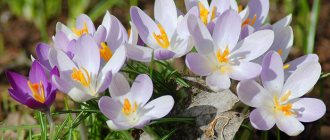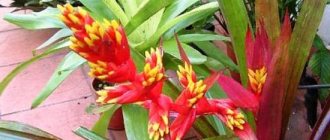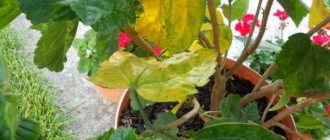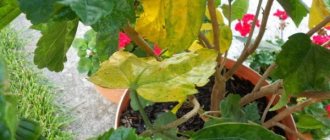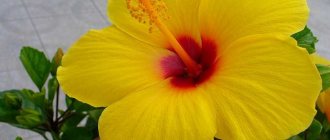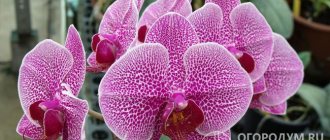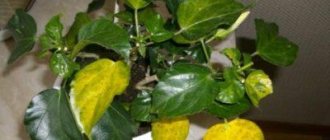Why feed hibiscus?
Why fertilize the plant at all? Isn't there enough water and the substances in the soil? No, not enough! The soil tends to deplete; over time, the hibiscus will “eat” most of the necessary substances, and then it will be necessary either to doom the flower to death, or to replant it, which is not always possible, or to fertilize it.
Also, fertilizing can play not only a supporting role, but also a stimulating one: thanks to them, the plant will bloom better and grow taller and faster.
You need to carefully monitor how much fertilizer has been added. Feeding is not a case where “the more, the better.”
Reproduction
Garden hibiscus can be propagated using:
- Rhizomes. By dividing it. This is the easiest way to reproduce. To do this, you need to dig up the plant and determine the main root. Mark the location of the cut so that the small annual roots are preserved. Chop the root into pieces. Ash is sprinkled on the cut to prevent it from rotting. The resulting root is buried in a hole, cut side down, and watered with warm water.
- Using cuttings. Woody branches are cut off along with the buds in the spring. Place in a container with a special solution. It must be changed periodically. When a large number of roots are formed, they are transplanted into a pot with soil.
- Using seeds. The herbaceous hibiscus is most suitable for this type of propagation. The seeds must be soaked for 10-12 hours in a special solution for root germination. Then they need to be washed in a weak solution of potassium permanganate, dried, and wrapped in cloth and polyethylene. Place in a warm place and ventilate periodically. After the first shoots have already appeared, plant them in the ground. They need good care.
Signs of Fertilizer Lack
A lack of nutrients in a plant is indicated by:
- deformation of leaves (thinning, drying), change in their color;
- delay or complete cessation of growth;
- reduction of the flowering period;
- reduction in flower size;
- weakening of the root system and its ability to absorb beneficial components;
- suspension of the formation of buds and side shoots.
- tendency to frequent illnesses.
Light mode
Hibiscus is sensitive to light. In the summer, it is recommended to move the plant to the garden, loggia, terrace. In good light, buds appear on the stems from spring to autumn. Hibiscus should be exposed to sunlight for 4-6 hours. The flower develops well when grown on windowsills facing west and east. Flowers exposed to the south need midday shade. Hibiscus will not bloom on the server. During the flowering period, you should avoid moving the flower. Caution will preserve the buds and flowers.
Types of fertilizers: how to choose the right one
All fertilizers for hibiscus can be divided into the following categories:
- To keep the plant alive.
- For the development of hibiscus (Whether it is flowering or accelerated growth).
- To prevent diseases/combat their consequences.
It is important to know that absolutely all fertilizers are divided into two groups, differing both in effect and dosage:
- Organic fertilizers.
- Inorganic fertilizers.
You need to choose fertilizer for hibiscus depending on its needs and the desires of the gardener.
Required soil composition for hibiscus
The new substrate into which the hibiscus was transplanted already contains a lot of nutrients, so fertilizing after the transplant is completed only needs to be done after a few months. The flower is transplanted in April and fed from September to March.
Hibiscus is suitable for any universal fertilizer for houseplants, low in nitrogen, in liquid form or in the form of sticks.
Hibiscus is unpretentious and can grow in any universal soil for flowering plants. To make the soil loose and breathable, you can add raising agents: perlite or vermiculite. Vermicompost in small quantities will increase the nutritional value of the soil in order to “feed” a powerful bush with a large mass of leaves and numerous flowers. The acidity of the soil should be close to neutral: pH 6–7, so the plant optimally absorbs nutrients. At the bottom of the pot you need drainage from a layer of expanded clay so that the roots can “breathe”.
The source of nutrition for indoor hibiscus, also called Chinese rose, is the soil in which it grows. It is important to take care of the correct composition of the soil to provide the flower with favorable growing conditions.
For normal development, ornamental crops need moisture- and breathable soil. Experienced flower growers recommend not to immediately plant a flower in heavy commercial soil containing peat. It will need to be pre-enriched with leaf humus. This component will help improve the structure of the soil and increase its moisture capacity. You can also use sand and turf soil as an additive. It is advisable to introduce charcoal or ash into the soil for growing hibiscus (the input rate is 2 cups and 10 kg of soil).
Hibiscus thrives in slightly acidic soil (pH 6.8). If the acidity of the soil does not correspond to the recommended value, the ornamental crop will not be able to fully absorb the nutrients it contains.
Chinese rose: a brief overview of the rules of care and cultivation
The Chinese rose is an indoor or garden flower that needs to create certain conditions for quality development. The decorative crop blooms in the spring and continues to delight the eye with luxurious flowers until the fall. The optimal lighting for the flower will be partial shade or diffused daylight. The plant should be watered as the top layer of soil dries. Recommended soil moistening depth: 2-3 cm.
We recommend viewing: Propagation of roses by cuttings at home
A florist who has a Chinese rose in his collection must know the following nuances of growing the crop:
- Young flower sprouts need to be replanted annually, and adult plants aged 5 years and older are replanted every 3-4 years;
- The dormant period in Chinese roses is weakly expressed;
- propagate the flower by cuttings and seeds;
- Chinese roses at home are pruned until the moment when buds begin to form on the stem, in the spring;
- decorative shrubs are fed twice a month with mineral complex compounds (feeding is applied in April-September);
- mineral fertilizing is interspersed with organic matter throughout the spring-summer season;
- it happens that the Chinese rose blooms in winter, and if this happens, the flower is fed with potassium-phosphorus compounds (they are taken in the amount of 1/4 of one dose);
- Chinese hibiscus develop well in high humidity conditions, so in hot weather it is recommended to spray the foliage of the plant with a spray bottle;
- Chinese rose is an indoor type of ornamental crop that most often suffers from attacks by whiteflies, aphids, thrips, spider mites, and mealybugs;
- The main diseases that can affect the plant are root rot, chlorosis, brown rot, bacterial spot, ring spot, leaf bronzing virus.
This article will introduce readers to the characteristics of Chinese hibiscus, features of cultivating a flower from seeds, aspects of care and propagation. You will also learn about the signs associated with this beautiful plant.
Fertilizer
How to feed indoor hibiscus?
In spring and summer, it is recommended to feed the plant with mineral fertilizers that contain nitrogen at least once a month. In winter, it is worth reducing fertilizing with nitrogen-containing fertilizers and starting to use fertilizer with a high content of phosphorus and potassium. It is also recommended to alternate and once a month, instead of mineral fertilizers, feed the hibiscus with mullein or bird droppings diluted with water in a ratio of 1:10.
You can fertilize your tea rose weekly with special complexes for indoor plants.
Among other things, the shrub needs magnesium, a lack of which can cause the leaves to turn yellow. Feeding is carried out on cool days, preferably early in the morning or late in the evening. It is necessary to fertilize only after watering the hibiscus.
Minerals
Many gardeners prefer mineral products. They contain all the nutrients necessary for Chinese rose. For normal development, decorative culture needs:
- Azote. Ensures flower growth, green mass growth, and root system development.
- Potassium. The substance is necessary for the normal course of metabolic processes in a green organism, photosynthesis. Promotes better budding.
- Phosphorus. Promotes root growth, strengthens the plant’s immunity, and makes it more cold-resistant.
The most suitable mineral fertilizers for indoor hibiscus are the following, including:
- Urea. It is used for foliar feeding, produced by spraying on the leaf. To obtain a nutrient liquid, dissolve urea (1 g) in water (1 l).
- Calimagnesia. The fertilizer is rich in potassium and magnesium. It is used to avoid falling leaves, deformation of leaf blades and pathological changes in their color.
Experienced gardeners advise resorting to feeding hibiscus with store-bought complex preparations such as:
They will help the Chinese rose:
- grow better;
- bloom faster and longer;
- resist diseases and insect pest attacks.
Organic matter
The following organic materials are suitable for feeding hibiscus:
To avoid burning the hibiscus root system, it is recommended to use manure and chicken droppings in the form of a diluted infusion. Activities such as infusing manure should be carried out at a summer cottage. The smell in the apartment can become unbearable.
To prepare the infusion:
- fill the bucket one third with manure or chicken droppings;
- to fill with water;
- leave for 3-4 days, stirring, so that excess ammonia evaporates;
- dilute a liter of mullein infusion with 10 liters of water, a liter of chicken infusion - 20 liters.
Green fertilizer is made as follows:
- Fill the container one third with grass;
- to fill with water;
- leave for 3 – 4 days.
Water at the root. Infusions of mullein, dung and herbs contain nitrogen and potassium. But for phosphorus nutrition you will have to use other substances of animal or plant origin. This is bone meal or wood ash.
Ash for hibiscus is used in dry form or poured with infusion - 300 g of ash per bucket of water. Ash solution is a source of potassium and phosphorus for roots and flowering. Ash has one drawback - low nitrogen content, since during combustion it evaporates into the atmosphere. Nitrogen fertilizers can be applied foliar. Dissolve 1 g of urea in a liter of water and spray with a spray bottle.
Bone meal has an advantage over other organic fertilizers - it costs less, is applied less frequently, and lasts longer. The substance is rich in calcium, potassium and especially phosphorus. You can use it once per season, since the fertilizer completely decomposes in the soil within six months. For 10 kg of soil mixture you need to add 2 cups of bone meal.
Home remedies for feeding hibiscus
Experienced flower growers have long noticed that hibiscus grows more actively, forms inflorescences better and blooms longer after fertilizing it with the homemade mixtures described below.
The best time for feeding is evening.
Planting process
In order for hibiscus to take root well and please the eye for many years, you need to choose the optimal place for its cultivation and good care. It is important to choose an area that is generously illuminated by the sun, but at the same time inaccessible to the winds. The soil should be fertile, light and breathable and sufficiently moist.
So a suitable site has been selected. Let's start landing. This process includes the following steps:
- You need to dig a hole that is approximately twice the size of the plant’s root system.
- It is necessary to lay drainage at the bottom. It can be made from broken brick, crushed stone or expanded clay.
- We lay layers of sand and compost in the following sequence: sand, compost, sand.
- We immerse the seedling in the hole, while the root collar should be slightly buried.
- Fill the rest of the hole with a mixture of garden soil, peat and sand. The proportion should be 2:4:1.
- We hill up and water the plant.
- Fill the remaining hole with soil and level the tree trunk.
Fertilizers for indoor hibiscus during flowering
Hibiscus or Chinese rose have long been decorating not only offices. The flower grows in almost every home thanks to the unearthly beauty of its inflorescences, the colors and shapes of which can be very diverse. Hibiscus is a plant that is not very demanding to care for and, in principle, not capricious. It is enough to choose suitable soil for planting, water and trim the flower in a timely manner and give it a bright corner in the apartment. However, in order for your pet to delight you with its flowers every year, you should pay a little more attention to it. It is especially important to support the plant with the onset of the most crucial period - when it begins to bloom.
What fertilizers can be used to feed indoor hibiscus during flowering? Complex mineral fertilizers are best suited. Today, specialized stores have a wide selection of drugs for these purposes. In addition, DIY home remedies have also gained wide popularity.
Chinese roses are fertilized by applying a nutrient solution to the root.
Blood infusion
For basting, use the water remaining after defrosting raw meat, or in which it was washed. Feed hibiscus no more than once every two weeks.
From sugar
- To provide indoor hibiscus with nutrients, you can sprinkle the surface of the soil with a small amount of granulated sugar (1 tsp) every time before watering.
- Sugar is also dissolved in water, which is watered at the root of the plant once every 7 days. To obtain a nutrient liquid, dissolve sweet sand (2 tsp) in water (250 ml).
Fertilizing provides the ornamental crop with glucose. This substance performs several important functions for a green organism:
- acts as a building material that ensures the formation of complex organic molecules of starch, cellulose, lipids, proteins, nucleic acids;
- is a source of energy that is necessary for the normal functioning of plant life processes (including the absorption of nutrients absorbed from the soil).
The flower should also be watered with sweet liquid in the spring so that it is stronger and healthier and grows better. Feeding with sugar also promotes abundant, long-lasting flowering of indoor hibiscus.
From glucose
Glucose solution also has beneficial properties of sugar bait. To obtain it, you need to dissolve the pharmaceutical drug (1 tablet) in water (1 l).
Banana peel infusion
Banana contains a large amount of potassium as well as magnesium.
These elements are very useful for flowering hibiscus; thanks to their influence, the plant will be able to bloom as many flowers as possible. To prepare the fertilizer you will need:
- 2 banana peels;
- 5 liters of warm water.
Cooking method:
- finely chop the banana peel;
- to fill with water;
- leave to infuse for 3 days;
- If the resulting solution is too thick, dilute with water.
How to use:
- Water the hibiscus once every 2 weeks.
- Use from late spring and all summer.
Possible problems
When wondering how to properly care for any planted plants, you need to remember the need to monitor their condition and immediately take action if something is wrong.
Disturbances in hibiscus flowering:
- bud drop due to lack of nutrients, cold or dry soil;
- lack of flowering - the reasons are usually an excess of nitrogen in the soil or insufficient lighting;
- brown edges of leaves - burn from the use of nitrogenous fertilizers;
- yellowing and falling leaves due to excessive watering (roots rot), excess chlorine and calcium in water for irrigation and lack of nitrogen and iron in the soil;
- light spots on the leaves are burns that appear if the plant is kept in direct sunlight;
- pest infestation.
Of the latter, the greatest damage is caused by spider mites and greenhouse whiteflies. Because of the mite, the leaves become covered with yellow spots and cobwebs appear on them. The whitefly carries various infections, and in addition, a sooty fungus develops on its feces (looks like a black coating), due to which the hibiscus dries out and may completely die.
Why the leaves turn yellow is a question that is asked by almost every owner of a houseplant, including the Chinese rose. And if such a problem occurs, you need to check:
- Is the flower watered enough: the soil in the pot should not be dry or too wet, like a swamp;
- Is the water for irrigation settled? Usually it comes from the tap too hard, its use leads to chlorosis of the soil;
- whether it is standing directly in the sun and at the same time whether there is enough light in the room;
- what is the temperature in the room: hibiscus is a tropical plant, so it is uncomfortable if the temperature around it is below +18˚C, but it should not be above +30˚C either;
- whether dirty spots, cobwebs, or small mites have appeared on the leaves;
- whether too much nitrogen or high-phosphate fertilizers have been applied.
Accordingly, if any violations in care are revealed, it is necessary to immediately begin to eliminate them: normalize watering, move the hibiscus to a lighted place under a canopy (but do not leave it in a draft), start spraying, bathing, add the necessary fertilizers to the soil, reduce the amount of nitrogen .
If the yellowing is caused by pests, you need to treat the flower with insecticides or soapy water. To make it bloom better, you can add a little phosphate fertilizer to the water for irrigation, but keep it in moderation. If the hibiscus turns yellow with proper care, an early transplant is needed: most likely, the soil is not suitable for it at all.
The problem of how to grow a Chinese rose is quite amenable to solution: it is necessary to observe the light and temperature conditions, water it in time with settled water, apply the necessary fertilizers, prune, replant and monitor for pests.
Fertilizers for hibiscus growth
If you want to grow not only a beautiful, but also the largest hibiscus, you should turn to the following recipes.
Yeast growth solution
To prepare the fertilizer you will need:
- 10 grams of yeast;
- 1 tablespoon sugar;
- 1 liter of water.
Cooking method:
- heat the water slightly;
- add yeast and sugar to it;
- leave to infuse for at least 2 hours;
- dilute with water in a ratio of 1/5.
Application:
Water the hibiscus with a yeast solution throughout the growth period once every 2-3 weeks.
Using coffee grounds or tea leaves
- Used coffee grounds are also used to feed indoor hibiscus. It should be added to the soil in the pot. It contains a large amount of nitrogen, which is necessary for the crop. After adding coffee to the soil, do not overwater the Chinese rose. This will allow the nitrogen to be evenly distributed. The thicket will make the soil looser.
- Tea brewing is also suitable for fertilizing purposes. The method of using it is similar to using coffee grounds. However, you should not overuse tea leaves, as it can cause midges to appear in the flower pot and souring of the soil.
Manure
Used from the second year of life (for 2 liters of water, 2 tablespoons of dried manure). Due to the special smell, it is better to use it when the plant is taken out into the open air.
Planting rules
The first question facing the future owner of hibiscus is: how to plant it. To do this, you need to purchase cuttings or seeds. You will need expanded clay, river sand and several types of soil - turf, leaf and humus. For growing at home, it is better to use cuttings. They can be cut from Chinese roses from friends or bought at a flower shop.
Before planting, it is recommended to root the cuttings:
- put expanded clay on the bottom of the container, on top of it - river sand and sheet soil (equal parts);
- pour this mixture over;
- plant the cuttings, bury them 1-1.5 cm;
- cover with a glass jar and wait for it to take root.
Another option is to use activated carbon water.
After the roots appear, you should plant the Chinese rose in a pot:
- cover the bottom with expanded clay;
- mix turf, leaf and humus soil with river sand (in a ratio of 4:3:3:1);
- plant a sprouted cutting;
- water well (watering is one of the main factors for successful growth).
It is recommended to buy the soil in a special store and pre-steam it in order to disinfect it, thereby protecting the rose from diseases.
If you decide to grow a flower from seeds, you should also prepare them before planting:
- soak in a small amount of water overnight;
- then place on damp gauze and place in a plastic bag with holes for air.
In such a container there will be a greenhouse effect - warm and humid. It is under these conditions that the seeds will grow. When the sprouts appear, they will need to be sprayed with warm water and ventilated.
The next stage after the leaves appear is planting the plants in small pots with humus and turf. With proper care of the Chinese rose at home, it will bloom:
- for 3-4 years when grown from seeds;
- next year when grown from cuttings.
In order for a rose to grow and bloom successfully, it should be placed in a sufficiently lit place, but not in direct sunlight. Rooms with windows facing east or west, with no tall trees or houses in front of them, are best suited. In summer, it is better to take this plant out onto the balcony, but under a canopy so that the sun does not burn its leaves. Burns significantly reduce hibiscus resistance to disease. Therefore, it must be kept in the fresh air, but under protection.
Life-saving nutrition for illnesses
What if it is not the growth or flowering of a plant that is of concern, but its very existence? And in this case, you can make a solution at home that will definitely bring the plant back to life.
Feeding from egg whites for a sick plant
An infusion of egg whites can no less effectively help a dying hibiscus cope with the consequences of the disease.
However, you need to prepare for the fact that the infusion will not have the most pleasant smell. To prepare the fertilizer you will need:
- 1 egg white;
- 1 glass of water (200ml);
- 2 liters of water.
Cooking method:
- mix 200 ml of water and egg white;
- place the mixture in a dark and cool place;
- let it brew for a week;
- dilute the mixture with 2 liters of water.
Application: water the hibiscus with the resulting solution once a week until the plant is completely cured.
Succinic acid solution
Succinic acid can save indoor hibiscus from certain death.
Also, succinic acid is an ecological and completely environmentally friendly plant growth stimulator. Thanks to its solution, you can significantly accelerate the growth of hibiscus!
To prepare the fertilizer you will need:
- 1 glass of water (200ml);
- 1 gram of succinic acid (can be bought at any pharmacy).
Preparation method: Add acid to water and stir until the substance is completely dissolved.
Application: spray the plant once every 3 weeks, depending on the growth of the hibiscus, increasing the concentration. The maximum magnification is 5-10 times.
Important! The solution is suitable for use for 3 days from the moment of creation.
Preventive spraying
To ensure that the hibiscus leaves sparkle and the plant is not attacked by spider mites, a couple of times a year you need to spray the Chinese rose with an infusion of onion peels. It’s not difficult to prepare an infusion: fill a three-liter jar halfway with husks, compact it, pour boiling water almost to the top, let it brew, strain.
Trimming
Pruning is an important procedure to speed up the growth and development of plants indoors. Poor lighting often leads to curvature of shoots. Removing deformed shoots will help correct the situation. The procedure is safe and promotes healing and rejuvenation of the plant. After pruning, active growth of new shoots begins; old and diseased shoots must be removed. The following types of pruning are distinguished:
- forming - indicated immediately after planting or transplantation, its purpose is to form the crown;
- trunk formation - carried out after the hibiscus has gained strength, branched shoots must be removed;
- supporting - removing unnecessary branches will help restore the plant’s decorative appearance;
- rejuvenating pruning - the purpose of pruning is to get rid of old branches and shorten young ones, the procedure provides stimulation for the formation of new shoots;
- hygienic - diseased, dry and old shoots must be removed.
All types of birch can be done at the same time, which reduces stress on the plant. The optimal time for the procedure is spring and autumn.
Buying a ready-made mixture in a store
If you don’t want to make fertilizers for your hibiscus yourself, you can always buy them. But in order not to stumble and buy the first thing you come across, you need to pay attention to the following:
- The fertilizing should not contain too much phosphorus. It is dangerous because in excess it causes chlorosis (iron stops being absorbed by the plant).
- The same applies to nitrogen in the fertilizer. Too much nitrogen will cause hibiscus leaves to burn.
- The ratio of substances in the fertilizer should be approximately: NPK 3:1:5.
The following tools have proven themselves to be effective:
- Athlete - 1.5 ml of the drug per 1 liter of water, water once every 7 days;
- Gilea - 2 caps of the drug per 1 liter of water, apply twice a month;
- Master - 5 g of the drug per 2 liters of water, water once a week.
Fertilizing should be done after standard watering of the plant so that the nutrients get into the moist soil.
In addition, you can alternate mineral and organic fertilizers using Gileya and Fertomix BIOHUMUS preparations for decorative flowering indoor plants. Frequency of use: every 10 days. Peat humus tablets, bone meal, urea, and potassium magnesia are also good for fertilizing indoor plants.
Forum of flower growers Frau Flora
About growing indoor and garden plants; discussion of species, varieties, diseases, pests.
- Unanswered topics
- Active topics
- Search
- About Us
Fertilizers for hibiscus
Moderator: Yavia
Fertilizers for hibiscus
Post by AISHA » 04 Jan 2013, 07:43
Fertilizers for hibiscus
What gorgeous hibiscus! Please share what you feed? Mine don't give more than 1 flower
Re: Fertilizers for hibiscus
Post by Larisa CHAJKA » 04 Jan 2013, 17:11
Re: Fertilizers for hibiscus
Post by Zlatenik » 05 Jan 2013, 16:43
Re: Fertilizers for hibiscus
Post by Svetlana55 » 05 Jan 2013, 18:41
Re: Fertilizers for hibiscus
Post by Zlatenik » 06 Jan 2013, 15:03
Re: Fertilizers for hibiscus
Post by Svetlana55 » 06 Jan 2013, 16:26
Re: Fertilizers for hibiscus
Post by Zlatenik » 06 Jan 2013, 16:52
Re: Fertilizers for hibiscus
Post by AISHA » 07 Jan 2013, 10:35
Re: Fertilizers for hibiscus
Post by Zlatenik » 07 Jan 2013, 14:41
Re: Fertilizers for hibiscus
Message from an amateur florist » Jan 11, 2013, 05:14 pm
Re: Fertilizers for hibiscus
Post by Svetlana55 » 11 Jan 2013, 19:38
Re: Fertilizers for hibiscus
Message from an amateur florist » Jan 15, 2013, 01:47 pm
Re: Fertilizers for hibiscus
Post by Svetlana55 » 15 Jan 2013, 20:21
Re: Fertilizers for hibiscus
Post by agafurova_959 » July 19, 2015, 1:50 pm
Fertilizers for hibiscus
Post by Yuriks » 11 Dec 2015, 18:39
Fertilizers for hibiscus
Post by Teri » 06 Mar 2016, 07:38
Please give advice to a novice hibiscus grower. I read various tips about keeping hibiscus and found a direct contradiction in some:
Fertilizer. The first source advises feeding with potassium-phosphorus fertilizer in the spring. And avoid nitrogen-containing fertilizers - hibiscus doesn’t like them too much. The second says exactly the opposite - in the case of hibiscus, phosphorus (unlike many other flowering plants) poisons the entire bush and negatively affects the number of inflorescences and their quality. And that the plant responds best to universal fertilizers, in which potassium and nitrogen predominate.
Fertilizers for hibiscus
Post by Florian » 06 Mar 2016, 10:56
Teri, in fertilizers for hibiscus the ratio of nitrogen, phosphorus and potassium is very important. The Yuriks message above yours indicates a fertilizer with the optimal ratio of these elements. Nitrogen is necessary for leaf growth; it cannot be completely abandoned, but its amount in the fertilizer should be minimal. Hibiscus cannot tolerate excess nitrogen; nitrogen burns the leaves and their edges turn brown.
Photo source Website
Hibiscus also does not tolerate too much phosphorus. Excess phosphorus causes chlorosis in hibiscus, because iron ceases to be absorbed.
Photo source Website
But potassium is very necessary for hibiscus and it should predominate in the fertilizer. Those. there should be approximately the following ratio N:P:K – 3:1:5.
When is the best time to apply fertilizer?
Experienced gardeners recommend fertilizing the flower from April to September. For this purpose, purchased mineral fertilizers are used. They are applied once every 28 days.
An alternative to mineral fertilizers is organic matter. To feed Chinese roses, we use a solution of cow manure or chicken manure, prepared in a ratio of 1:10.
We fertilize only in spring and summer, when the outside temperature exceeds +10 degrees. This is due to the fact that in the cold season the plant does not absorb fertilizers well. Also in winter, the rose does not have enough light for active photosynthesis.
During the winter months, complementary feeding can be introduced only if the plant is blooming. In this case, a phosphorus-potassium mixture is used. It is used in a reduced dosage (1/4 of the norm for applying fertilizers in the spring and summer).
Spring
In spring, Chinese roses require a lot of nitrogen for active growth. During this period we add organic fertilizer. To prepare the solution, dilute 1 liter of mullein in a bucket of warm, settled water. Use the resulting solution to water the rose on the damp soil. This fertilizer can be applied once every two weeks.
Summer
In the summer, we feed the rose with a complex fertilizer, which includes potassium, nitrogen, phosphorus, magnesium and other elements necessary for plant growth. This fertilizer can be purchased at a specialty store or prepared independently.
To do this, dilute 1 glass of wood ash in 1 liter of warm, settled water. It contains more than 30 useful microelements. Use the resulting solution to water the rose on the damp soil. Thanks to this feeding, the rose bush will actively grow and develop, as well as bloom beautifully.
Growing rules
They include:
- choosing a suitable place for a flower;
- planting in the required soil;
- organizing the required watering and fertilizing regime;
- creating humidity by any available means;
- ensuring comfortable temperature and lighting;
- pruning and shaping the bush.
Depending:
- Depending on the time of year.
- In spring and summer, intensive watering, fertilizing, frequent spraying, temperature within 28 degrees, and good lighting are required.
- In winter, hibiscus should have a dormant period and, accordingly, it is necessary to lower the temperature to 16 degrees, water and spray less, and do not fertilize.
- From the flowering of a plant.
- Before and during flowering, it is necessary to carefully monitor watering and humidity, and do not forget about fertilizing - otherwise flowering will be weak. If the temperature is low, the buds may fall off, the same applies to lighting - during this period you need bright light.
- After flowering, the Chinese rose needs rest, so feeding is stopped completely, watering is reduced and the temperature gradually decreases.
- Depending on the type of Chinese rose, regardless of the type, the conditions of maintenance and care are the same.
When you don't need to add nutrients
It is not recommended to feed indoor hibiscus during the following periods:
- within 14 days after transplanting the plant into a new container;
- when the pot with Chinese rose is in a draft;
- during the hot period at the height of the day;
- with sudden changes in temperature.
Hibiscus is an easy-to-care crop. However, for the correct development of the flower and its long and abundant flowering, it needs proper feeding. You should know when and what to feed your indoor Chinese rose so as not to harm the plant.
Transfer
Hibiscus transplantation is carried out simultaneously with pruning. It is recommended to replant young plants annually, adults 2-3 times annually. When transplanting, use a large container. The difference in the size of the pots should be two phalanges. Transplanting hibiscus into a large pot can lead to increased growth of green mass and the absence of buds. Old plants are rarely replanted. An excellent alternative is to replace the top layer of soil with a new one. When filling the container, a nutrient substrate with humus is used. It is laid on a drainage layer. Transplantation is carried out using the transshipment method. It is recommended to fertilize every 2-3 months. after transplantation. Complex fertilizers for house flowers with a low nitrogen concentration are recommended to be applied in winter or autumn.
